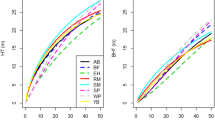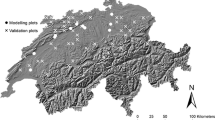Abstract
Forest managers often estimate gains from site preparation treatments during plantation establishment using the reduction in time required to grow a given yield compared with a control (when treatments are employed compared to when they are not employed). Two types of responses to treatments have been identified; temporary changes that offer a time gain that becomes constant after site changes cease to affect growth (type I) and persistent changes that result in a continuously increasing time gain throughout a crop rotation (type II). An alternative to this statistical approach is to use a hybrid physiological/mensurational model of forest production that explicitly represents growth processes underlying observed responses. We compared a regional hybrid growth and yield model with a purely mensurational one for representing observed responses in two site preparation experiments in the Central North Island region of New Zealand. Simulations were initiated with crop measurements following the first 5 years of growth in the two experiments, along with reasonable estimates of impacts of site preparation on sites and growth processes. These estimates of site changes were made prior to the simulation and were not varied after simulation results were known. The hybrid model successfully predicted a type I response following weed control and a type II response following soil cultivation, while the mensurational model failed to represent the type II response. Growth in basal area without soil cultivation was underestimated by 3 m3 ha−1, leading to an overestimate of gain. A hybrid modelling approach is therefore an alternative to a purely statistical time gain analysis that can provide useful estimates of gain so long as changes to sites and growth processes made by site preparation are well understood.


Similar content being viewed by others
References
Albaugh TJ, Allen HL, Zutter BR, Quicke HE (2003) Vegetation control and fertilization in midrotation Pinus taeda stands in the southeastern United States. Ann For Sci 60(7):619–624. EDP Sciences, Les Ulis
Boateng JO, Heineman JL, Bedford L, Linnell Nemec AF, McClarnon J, Powelson RA (2012) Twenty year site preparation effects on sub-boreal lodgepole pine performance. New Forest 43(4):457–472
Bown H, Watt MS, Clinton PW, Mason EG, Richardson B (2007) Partitioning concurrent influences of nitrogen and phosphorus supply on photosynthetic model parameters of Pinus radiata. Tree Physiol 27:335–344
Glover GR, Zutter BR (1993) Loblolly pine and mixed hardwood stand dynamics for 27 years following chemical, mechanical, and manual site preparation. Can J For Res 23(10):2126–2132
Landsberg JJ, Waring RH (1997) A generalised model of forest productivity using simplified concepts of radiation-use efficiency, carbon balance and partitioning. For Ecol Manage 95:209–228
Lauer DK, Glover GR (1999) Stand level pine response to occupancy of woody shrub and herbaceous vegetation. Can J For Res 29(7):979–984
Lauer DK, Glover GR, Gjerstad DH (1993) Comparison of duration and method of herbaceous weed control on loblolly pine response through midrotation. Can J For Res 23(10):2116–2125
Lof M, Dey DC, Navarro RM, Jacobs DF (2012) Mechanical site preparation for forest restoration. New Forest 43(5–6):825–848
Mason EG (1991) A forest establishment or regeneration decision framework. In: Menzies MI, Parrot GE, Whitehouse LJ (eds) Proceedings of the IUFRO symposium on efficiency of stand establishment operations, Rotorua, September 1989. Zealand Forest Research Institute Bulletin, pp 366–377
Mason EG (2001) A model of the juvenile growth and survival of Pinus radiata D. Don. Adding the effects of initial seedling diameter and plant handling. New Forest 22(1/2):133–158
Mason EG (2005) Effects of soil cultivation, fertilisation, initial seedling diameter and plant handling on the development of maturing Pinus radiata D.Don on Kaingaroa gravelly sand in the Central North Island of New Zealand. Bosque 25(2):43–55
Mason EG (2006) Effect of genotype and grass competition on growth and wood stiffness of radiata pine in a summer-dry environment. Can J For Res 36(10):2454–2463
Mason EG, Cullen AWJ (1986) Growth of Pinus radiata on ripped and unripped Taupo pumice soil. NZ J Forest Sci 16(1):3–18
Mason EG, Milne PG (1999) Effects of weed control, fertilization, and soil cultivation on the growth of Pinus radiata at midrotation in Canterbury, New Zealand. Can J For Res 29:985–992
Mason EG, Whyte AGD, Woollons RC, Richardson B (1997) A model of the growth of juvenile radiata pine in the Central North Island of New Zealand: links with older models and rotation-length analyses of the effects of site preparation. For Ecol Manage 97(2):187–195
Mason EG, Rose RW, Rosner LS (2007) Time vs light: a potentially-useable-light-sum hybrid model to represent the juvenile growth of Douglas-fir subject to varying levels of competition. Can J For Res 37:795–805
Mason EG, Methol R, Cochrane H (2011) Hybrid mensurational and physiological modelling of growth and yield of Pinus radiata D.Don. using potentially useable radiation sums. Forestry 12(2):99–108. doi:10.1093/forestry/cpq048
Mason EG, Diepstraten M, Pinjuv GL, Lasserre JP (2012) Comparison of direct and indirect leaf area index measurements of Pinus radiata D. Don. Agric For Meteorol 166–167:113–119
Mead DJ, Gadgil RL (1978) Fertiliser use in established radiata pine stands in New Zealand. NZ J Forest Sci 8(1):105–134
Menzies MI, Chavasse CGR (1982) Establishment trials on frost-prone sites. NZ J Forest 27(1):33–49
Methol R (2001) Comparisons of approaches to modelling tree taper, stand structure and stand dynamics in forest plantations. PhD, University of Canterbury, Christchurch
Montieth JL (1972) Solar radiation and productivity in a tropical ecosystem. J Appl Ecol 9:747–766
Montieth JL (1977) Climate and efficiency of crop production in Britain. Philos Trans R Soc Ser B 281:277–294
Morris LA, Lowery RF (1988) Influence of site preparation on soil conditions affecting stand establishment and tree growth. South J Appl Forest 12(3):170–178
Peri PL, Mason EG, Pollock KM, Varella AC, Mead DJ (2002) Early growth and quality of radiata pine in a silvopastoral system in New Zealand
Pienaar LV, Rheney JW (1995) Modeling stand level growth and yield response to silvicultural treatments. Forest Sci 41(3):629–638
Pinjuv G (2006) Hybrid forest modelling of Pinus radiata D. Don. in Canterbury, New Zealand. University of Canterbury
Preest DS (1977) Long-term growth response of Douglas fir to weed control. NZ J Forest Sci 7(3):329–332
Richardson B (1993) Vegetation management practices in plantation forests of Australia and New Zealand. Can J For Res 23(10):1989–2005
Richardson B, Kimberley MO, Ray JW, Coker GW (1999) Indices of interspecific plant competition for Pinus radiata in the central north island of New Zealand. Can J For Res 29(7):898–905
Snowdon P (2001) Modeling type 1 and type 2 growth responses in plantations after application of fertilizer or other silvicultural treatments. For Ecol Manage 5632:1–16
Snowdon P, Waring HD (1984) Long-term nature of growth responses obtained to fertiliser and weed control applied at planting and their consequences for forest management. In: IUFRO symposium on site and site productivity of fast growing plantations, Pretoria and Petermaritzberg, South Africa, 1984. pp 701–711
Walcroft AS, Whitehead D, Silvester WB, Kelliher FM (1997) The response of photosynthetic model parameters to temperature and nitrogen concentration in Pinus radiata D.Don. Plant, Cell Environ 20:1338–1348
Watt MS, Whitehead D, Mason EG, Richardson B, Kimberley MO (2003) The influence of weed competition for light and water on growth and dry matter partitioning of young Pinus radiata, at a dryland site. For Ecol Manage 183(1–3):363–376
Wilhite LP, Jones EPJ (1981) Bedding effects in maturing slash pine stands. South J Appl Forest 5(1):24–27
Will GM, Stone EL (1967) Pumice soils as a medium for tree growth. 1. Moisture storage capacity. NZ J Forest 12(2):189–199
Woollons RC, Whyte AGD, Mead DJ (1988) Long term growth responses in Pinus radiata fertiliser experiments. NZ J Forest Sci 18(2):199–209
Zou C, Sands R, Buchan G, Hudson I (2000) Least limiting water range: a potential indicator of physical quality of forest soils. Aust J Soil Res 38(5):947–958
Acknowledgments
The experiments used in this study were established and measured with the help of my colleagues at the Silvicultural Equipment Research group at the New Zealand Forest Research Institute, and I am extremely grateful to them. Late rotation measurements at the Kangaroa site were funded by the University of Canterbury.
Author information
Authors and Affiliations
Corresponding author
Rights and permissions
About this article
Cite this article
Mason, E.G. Linking hybrid mensurational/eco-physiological growth and yield models with crop establishment: a replacement for time gain analysis. New Forests 44, 951–959 (2013). https://doi.org/10.1007/s11056-013-9387-3
Received:
Accepted:
Published:
Issue Date:
DOI: https://doi.org/10.1007/s11056-013-9387-3




